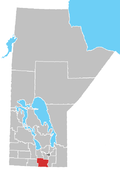St. Jean Baptiste, Manitoba
St. Jean Baptiste | |
|---|---|
Location of St. Jean Baptiste in Manitoba. | |
| Coordinates: 49°15′56″N 97°20′23″W / 49.26556°N 97.33972°W | |
| Country | Canada |
| Province | Manitoba |
| Region | Pembina Valley |
| Rural Municipality | Montcalm |
| Government | |
| • MP (Provencher) | Ted Falk (CPC) |
| Area | |
• Total | 2.02 km2 (0.78 sq mi) |
| Population | |
• Total | 576 |
| • Density | 285.2/km2 (739/sq mi) |
| Time zone | UTC-6 (CST) |
| • Summer (DST) | UTC-5 (CDT) |
St. Jean Baptiste is an unincorporated community recognized as a local urban district[2] in Manitoba. It is located in the Rural Municipality of Montcalm along Highway 75, 40 km north of Emerson at the United States border, and 60 km south of Winnipeg.
The community has a distinct French-Canadian culture. The area was first settled by Métis families from St. Norbert, Manitoba; in 1878, French-Canadian families from the United States arrived in the area and purchased land. The post office opened in 1877 and a parish and Canadian National Railway point were also part of the early development.
The community was originally called Grosse Pointe, then was renamed Mission de la Rivière aux Prunes, before receiving its present name from Archbishop Taché in 1872. It has since been known as St. Jean Baptiste (or simply, St. Jean).
Demographics
[edit]In the 2021 Census of Population conducted by Statistics Canada, St. Jean Baptiste had a population of 576 living in 246 of its 258 total private dwellings, a change of 2.3% from its 2016 population of 563. With a land area of 2.02 km2 (0.78 sq mi), it had a population density of 285.1/km2 (738.5/sq mi) in 2021.[3]
References
[edit]- ^ "Census Profile, 2021 Census of Population". Census Canada. Retrieved December 12, 2023.
- ^ "Local Urban Districts Regulation". Government of Manitoba. April 23, 2016. Retrieved April 24, 2016.
- ^ "Population and dwelling counts: Canada and designated places". Statistics Canada. February 9, 2022. Retrieved September 3, 2022.
- Geographic Names of Manitoba (pg. 238) - the Millennium Bureau of Canada
- Paroisse St-Jean-Baptiste, Manitoba
- Hotel Pierre Parenteau, St. Jean Baptiste Manitoba Historical Society


